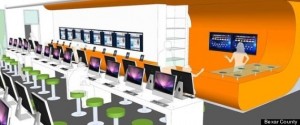 People in Bexar County, Texas, should be excited about the 10,000-e-book “BiblioTech” library system that the country is starting from scratch—without paper books.
People in Bexar County, Texas, should be excited about the 10,000-e-book “BiblioTech” library system that the country is starting from scratch—without paper books.
This is reportedly the first U.S. public library system to shun paper, cardboard and ink, except for computer printouts.
Any books are better than none, and besides, the 10K figure encompasses only copyrighted books, not the tens of thousands of free classics that library patrons will be able to read electronically. What’s more, Bexar will add to the 10,000. County Judge Nelson W. Wolff, the main brain behind the plan, deserves praise for his open-mindedness about e-books, their cost-saving potential and other advantages. Many people, especially dyslectic Americans and especially senior citizens in need of large “print,” are starting to prefer E. As a babyboomer, I do. My sister is a retired teacher and likewise reads faster in E. The technology is good now and will only get better for all ages. Nice going, Judge.
Judge Wolff and other Bexar Countians, however, should look beyond the current vision of a library branch whose possible appearance brings to mind an Apple Store. Even with many more e-books added, 10,000 will still be a dwarf-sized library compared to the possibilities beyond physical walls.
 However modern is the planned library, it is no replacement for two well-stocked and tightly intertwined national digital library systems, one public and one academic, serving up more books than Google and Amazon combined. A mere dream? Not necessarily—if policymakers, publishers, writers, literary agents and others in the content industries can work toward the creation of a Library-Publisher Complex, efficient and taxpayer-sensitive.
However modern is the planned library, it is no replacement for two well-stocked and tightly intertwined national digital library systems, one public and one academic, serving up more books than Google and Amazon combined. A mere dream? Not necessarily—if policymakers, publishers, writers, literary agents and others in the content industries can work toward the creation of a Library-Publisher Complex, efficient and taxpayer-sensitive.
Most American adults own library cards. The political muscle will be there to grow library appropriations at all levels of government; and we can help fill in the gaps through philanthropy, subscription plans with special breaks for the poor, and other means. The key is to get librarians and content-providers in sync for library users to enjoy a cornucopia of e-books and additional items matching their needs and interests—so, so important to K-12 students.
Ten thousand books is far from a disaster for a local branch, real or virtual; but remember that among the AWOL books will be bestsellers and other titles that the children and their parents are most eager to read. Here’s to family literacy campaigns, including early-childhood efforts, among the best re-enforcers of K-12-related literacy!
With the above in mind, Bexar County people should also read the writings of a Harvard MBA named Brian O’Leary, a distinguished publishing industry expert, as well as the comments of Sarah Houghton, a librarian in San Rafael, Ca., who understandably worries about the number of bestsellers and other e-books available to public libraries, in addition to related restrictions. The headline over a just-published O’Leary piece says it all: “(Market) Size matters. The biggest threat to publishing: people not reading.” Also extra-worthy of your time would be a 2011 post from him, The opportunity in abundance.
Like Brian O’Leary, I don’t mean abundance by expecting publishers to give away their wares to libraries for free. Via the economies of scale, we could make them better off while at the same time driving down costs to the public.
Not that e-books are an instant panacea. As Sarah Houghton has noted in an NPR interview and as I myself would recognize, many people today favor paper books; and if nothing else, what about young toddlers who may take better to the paper variety initially? Not to mention other factors: I don’t want a library looking like an Apple store. I’d like it to be full of comfy chairs of all kinds. I’d like it to make young people, especially, feel welcome.
No small issue. But, yes, just as Sarah has said, issue number one is content. Dwarf-sized digital public libraries—the result of excessive vendor domination of the e-library world, as well as too much fixation at the local level on Everything Invented and Done Here—are not what we need to help keep the United States competitive in the 21st century.
Local libraries, even with a national approach, could still exercise independence by way of the content they most prominently played up on their Web sites and in in-person programming. Let national empower local! Let San Antonio-area schoolchildren and their parents enjoy access to virtually every book written on the Alamo, as well as related material from historical societies and universities there and in other locations.
Besides the content issue, I also wonder if the forthcoming Bexar e-library will offer enough desktop computers and borrowable e-book readers to accommodate peak usage. A county news release mentions plans for “100 e-readers for circulation, 50 pre-loaded enhanced ereaders for children, 50 computer stations, 25 laptops and 25 tablets to use on site; additional e-reading accommodations will be made for the visually impaired.”
Enough if this library system really catches on? This is one reason why I favor a separate public digital system at the national level, since academics don’t fret as much over digital divide issues and the availability of the right hardware and technical support. I also advocate cost-savings through a nonprofit’s buyout of OverDrive, the main e-book supplier for libraries—perhaps a purchase through philanthropic contributions via the Harvard-originated Digital Public Library of America initiative.
Of course, libraries are about a lot more than books and gadgets, and for a general overview of the possibilities, Bexar Countians might also check out It’s time for a National Digital Library System. But it can’t serve only the elites, commentary in the February 24, 2011, issue of the Chronicle of Higher Education.
Yes, not just the elites! Bexar Countians’ per capita income as of the 2000 census was just $18,363, and even more than a decade later, I doubt it is in the same league as, say, Beverly Hill’s or that of Cambridge, Massachusetts. Well-stocked national digital library systems could help rich and poor areas alike, but be especially beneficial to places like Bexar and the state of Texas as a whole. In fiscal year 2009, according to a report from the Institute of Museum and Library Services, Texas spent $2.61 per capita operating expenses on books and other items, compared to an also-stingy $4.41 for America as a whole. Properly thought out, national digital library systems could go a long way toward narrowing the gap.
This is a cause dear to me. I’ve been on the national digital library cause for two decades and am endlessly thrilled to see County Judge Wolff sharing my passion for E even if I’m hoping for a some tweaks in his plan (from afar he strikes me as the kind of fellow who would be reasonable on such issues as paper books for, say, those toddlers who respond best to them). Recognizing the potential of libraries as cost-effective {PDF} life-enrichers—in line with Andrew Carnegie’s vision—William F. Buckley Jr. wrote two “On the Right columns” in the 1990s for the national digital library vision. Time for President Obama to catch up in a serious way and include the digital library issue in his 2013 State of the Union Address?
Meanwhile my message to Judge Wolff and Bexar County is this:
Enjoy your spiffy new e-library when it’s done, but push Congress to take a little time off from Fiscal Cliffing and aim for a truly strategic vision for U.S. libraries. Think of this as an existential issue like national security, in fact a form of it. If we want to call the enabling legislation The National Defense Digital Library Act, that’s fine by me. Just get it passed!
Detail: Sarah would really like Bexar to wait another decade or so. I myself see the virtues of experimentation as long as ample provisions are made for paper book stalwarts. I wonder if people in the new all-E library will be able to order pulped-wood loaners from afar. But that still isn’t the same as having them on the shelves—or low tables—for toddlers to play with.
Note: This article originally appeared on LibraryCity.org, and is Creative Commons-licensed content.
































The diorama of connectivity between individuals and wider infrastructures of information has scenes from the telegraph to the Internet. The book centric version extends from papyrus codex to screen formats. A consistent trend through all these shifts has been an increasing displacement of human mediation.
Manipulative skills of the codex, the dexterity of the keyboard, the touch navigation of the phone feature direct prompts but the related infrastructures of connectivity are increasingly layered and increasingly machines process the transactions. The connectivity between the reader and information has become impenetrable.
Some argue that access between reader and information is becoming dominated by system expedients. A further argument positions the reader as an accessory of network transactions. Another projection beyond that suggests neurological adaptation of bionic reader to automated search, discovery and display routines.
Libraries demonstrate these shifts of increasing displacement of human mediation. Libraries also present consequences of the shifts themselves. The libraries are necessary not only as a test-bed for changing reading behaviors but as repositories for comparative media studies of distinctions between bionic and machine processing and their “epigenetic”, or non-genetic, evolutionary influence on culture transmission.
A great source on all this is Kate Hayles, How We Think, University of Chicago, 2012.
Thanks, Gary, for illustrating the need for intertwined but separate public and academic systems. Hayles is a leader in her field. But for TeleRead, let’s discuss the issues in an intelligent way at a lay level without jargon. As for the substance of your comments, I myself want MORE human interaction, not less; and used well, E can promote this.
Happy Year,
David
David,
Thanks for the helpful comment. I agree that the continuing role of books needs no-nonsense examination. TeleRead is a model forum for the discussion and I visit every day. It is the place to go for screen book news.
I suspect that news is inherently redundant for a medium that intends to describe surprising events. In the small sector of book centric news TeleRead news has consisted, over and over, of format competitions (print/screen/audio), new production and provider services, and new authoring/reading behaviors. My question is have you observed changes that encompass the news stream?
Any such mega-shifts in the role of books are probably long term. Suggested is the one I mentioned of increasing technological mediation (books are now in the cloud). Another shift is the continuing, almost eerie intertwining of delivery formats and their interdependent sectors of transmission. This shift is a favorite of scholars who contend that simple supersession of one medium for another is wrong. Another shift is increasing mobility. It turns out that the incubation niche for the screen book is the phone. Another shift, as you contend, is the increasing role of libraries in support of wider, more comprehensive literacies that challenge students to cross over disciplines and combine media.
If you look over the TeleRead topics that provoke comments and contrast those with others that don’t you can also mine another bit of news. Comparative topics of pricing or devices are of interest and comparative publishing trends too. Your advocacy of wider library role in book transmission, very informed and persuasive, encompasses pricing, devices and publishing and moves beyond to treat the mega-trends as well. In my view this is really “news”. Thanks! Gary
@Gary: Thanks for the kind words. I’m grateful that Dan, Juli, Joanna, Chris, Jon and the others are there to carry on what I started at TeleRead.
As for books and news streams of various kinds, yes, we were writing years ago about the inclusion of timely updates within books. I’m not sure if publishers have pushed this as much as they could, given the ease of simply inserting Web links. But I suspect we’ll see more of this. Of course, with the cloud approach, lines will blur between what’s in a book and what isn’t. The library model is by far the best for the cloud era (not that I think it should be the only one) because of the greater stability of links and the rest.
In terms of e-book news itself, I’m pleased that we have more sources of it than ever. At the same time it’s more difficult to define “e-book news,” given the rise of book apps and the displacement of dedicated e-book readers in some cases by general-purpose tablets (even though E Ink machines are hardly about to vanish and may be more popular when color E Ink is better and cheaper!).
Finally, as far as libraries and the news, I’d like to see more use of libraries as to encourage intelligent local and civic blogging — and upgrade journalism. Check out http://librarycity.org/?p=5926 and http://librarycity.org/?p=6083
That said, I hope that libraries will expand, not shrink, their role in the book world. Formats, in various senses of the word, will come and go. But if nothing else, we’ll always have long narratives in one form or another.
Thanks,
David